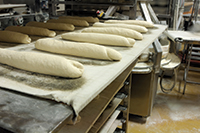
Tricks of the Trade: November 2011
October 31, 2011
By
FORMA-LAB
Troubleshooting a common problem with par-baked bread crust.

|
|
| Don’t let your dough get too firm or use too much dough improver when making par-baked bread.
|
With its delicate, golden crust, par-baked bread can be a beautiful thing. But when that crust starts to peel and break off the loaf, it’s a whole other story.
The following factors may contribute to crust peeling:
Overly firm dough
A dough that is too firm will not expand properly and will need more humidity in the proofer or steam room. Without it, the bread will have a drier skin. If the skin of the bread remains dry, it will cause the crust to peel off.
Too much dough improver
Giving your loaves an overdose of dough improver or conditioner will bring about faster dough development, but it will also dry the bread more quickly. As the bread dries, the crust dries as well, and becomes more prone to peeling.
Overmixed dough
Overmixed dough will develop quickly. It will also have less tolerance in the proofer and in the oven. If you overmix your dough, you will wind up with a bread that gives a crisp, crumbly crust.
Overly dry fermentation
A proofer without sufficient humidity will dry the skin of the bread, resulting in a peeling crust. You should aim for at least 70 per cent relative humidity in your proofer. This is the humidity level relative to the desired proofing temperature.
Insufficient oven steam during baking
Injecting vapour is an essential step in the production of par-baked bread – it is the secret to success. If vapour is not controlled during the first bake, your bread will lack stability.
First bake is too long
Avoid any tinting or colouring of the bread during the initial bake. If par-baked bread is allowed to colour during this first bake, it begins to develop a crust. This crust may flake off due to friction between loaves or against packaging.
Improper ressuage time
It is very important to allow the vapours and gases trapped in the bread to escape before freezing. Freezing the bread without allowing sufficient time for ressuage, or gas escape, can lead to condensation in the deep freeze. This can contribute to drying of the crust, which may peel once the frozen loaves are packaged.
On the other hand, allowing too much time for ressuage will dry the bread out, which can also cause the crust to peel.
As a rule, ressuage time should not exceed five minutes.
Improper blast freezing
In order to ensure freezing does not damage your loaves, monitor conditions carefully. If the temperature is too low, the freeze is too long, or the force of the air in the blast freezer is too strong, it may affect the bread’s crust.
Packaging
Inadequate packaging may contribute to crust peeling by allowing the loaves to rub against one another, or against the packaging itself. A plastic bag is important in prolonging the shelf life of frozen loaves.
For breads weighing more than 340 grams (12 ounces), I suggest using a separator to keep the loaves from rubbing together.
Too much scarification
Too much scarification, or scarification that is too deep, will cause the crust to peel when exposed to friction between loaves or against packaging.
Improper second bake
The second round of baking can cause the crust to peel if the initial bake is not done properly. The purpose of the second bake is to give the loaves a golden crust. This is done by baking the loaves in an oven injected with vapour. An oven with insufficient heat will require a longer baking time, drying the crust and making it vulnerable to peeling.
Remember that when the crust peels off, the bread will be left without any tint or colouring, even after the second baking.
Mario Fortin is an international bakery consultant and owner of FORMA-LAB, a consulting service for bakers and suppliers. If you have a technical problem, send your question to info@forma-lab.com.
Print this page
Leave a Reply